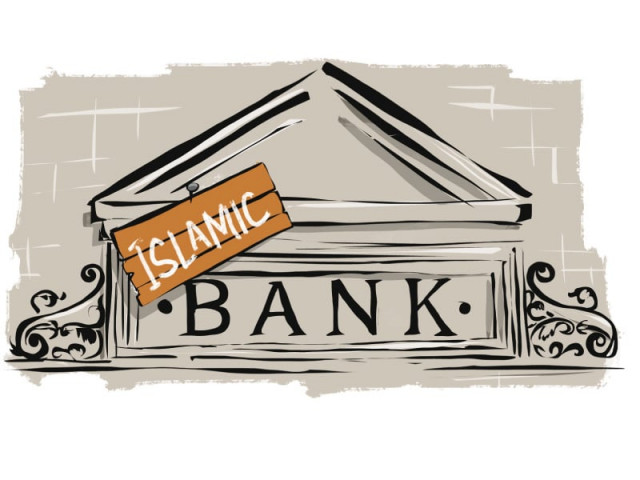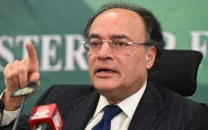Shariah compliant: Islamic banking and finance – where does Pakistan stand?
Besides Iran and Sudan, this system will have a share of 50% in six countries by 2020.

Focusing on Islamic banking only, it will require an annual growth rate of 66.67% for Islamic banks for the next six years to capture 50% of market share. ILLUSTRATION: JAMAL KHURSHID
These six countries are in addition to Iran and Sudan, which claim to have fully-fledged Islamic financial systems already in place.
It is almost certain that Brunei Darussalam, Saudi Arabia, Kuwait, Qatar, Malaysia and the UAE will have their financial sectors dominated by IBF by 2020.
Brunei Darussalam will be the first country to witness the share of IBF in the domestic financial sector exceeding 50% by 2020. Almost 45% of retail banking in the country already meets basic Shariah requirements. More impetus is needed for the capital markets, which require a little more guidance and support from the Ministry of Finance.
Given its small and overwhelmingly religious population, it will not be surprising to see Brunei Darussalam emerging as a nation where the IBF share is greater than conventional banking and finance.
Similarly, Saudi Arabia will have its financial sector predominantly Shariah compliant by 2020. It currently has over 55% of its retail banking sector already in compliance with Shariah and it will have to streamline Islamic banking and finance, with official recognition of it by the Saudi Arabian Monetary Agency and the Capital Market Authority.
If Brunei Darussalam has not already achieved the milestone, Saudi Arabia could be the first country to boast of having Islamised the bulk of banking and finance practice in the country.
Since the establishment of Kuwait Finance House (KFH) in 1977, Kuwait has been at the forefront of IBF. It is expected that it will be ahead of Qatar in achieving the threshold of 50% share. With the current market share at 35%, Kuwait’s IBF industry will have to grow by 7.14% annually for the next six years to achieve the milestone of 50% market share.
Furthermore, its existing Islamic financial institutions will have to take over 3.15% market share from the conventional financial institutions during the same time period.
Qatar is another country with huge potential for growth in IBF. Unfortunately, the likelihood of IBF reaching the 50% threshold was adversely affected by the government’s decision to disallow conventional banks offering Islamic banking through window operations. However, it is still likely that IBF will have no less than 50% market share by 2020.
Malaysia is another country that has made tremendous progress in IBF. With strong support from the government and the central bank, Malaysia has certainly taught other countries, notably Pakistan and the UAE, how government patronage of IBF can actually bring wider economic benefits to the country.
The weakest link, however, in this list of six countries is the UAE. Despite the government of UAE’s strong support for IBF, the country will be able to just make the 50% mark by the end of 2020. This relative less impressive growth is even more significant, given that there will be a lot of economic activity in Dubai and in the wider UAE in the wake of Expo2020, which Dubai is going to host.
Pakistan’s share far lower
This brings us the million-dollar question: where does Pakistan stand in this respect? Given the 10% market share of Islamic banking, and far lower share of IBF in the financial sector (including insurance, capital markets, etc), it will take a very long time for Pakistan to touch the 50% mark.
Focusing on Islamic banking only, it will require an annual growth rate of 66.67% for Islamic banks for the next six years to capture 50% of market share. To do so, Islamic banks will also have to cannibalise 7.4% of the conventional business on an annual basis during the same period. This is certainly a steep task but the momentum is in the right direction.
The mood of newly appointed deputy governor (for Islamic banking), Saeed Ahmed, at the State Bank of Pakistan (SBP), who is widely believed to be the next governor of the central bank after the recent resignation of Yaseen Anwar, is buoyant regarding Islamic banking, and it will be interesting to see if Islamic banking can hold equal market share with conventional banking by 2025.
To do so, Islamic banking assets will have to grow by 36.36% annually for the next 11 years, during which time they should also capture 4% of the business of conventional banks. Given that Islamic banking has been growing in Pakistan at a rate of 35% annually for the last few years, this is a realistic target that Ahmad should aim for.
The writer is an economist and a Phd from Cambridge University
Published in The Express Tribune, February 10th, 2014.
Like Business on Facebook, follow @TribuneBiz on Twitter to stay informed and join in the conversation.



















COMMENTS
Comments are moderated and generally will be posted if they are on-topic and not abusive.
For more information, please see our Comments FAQ